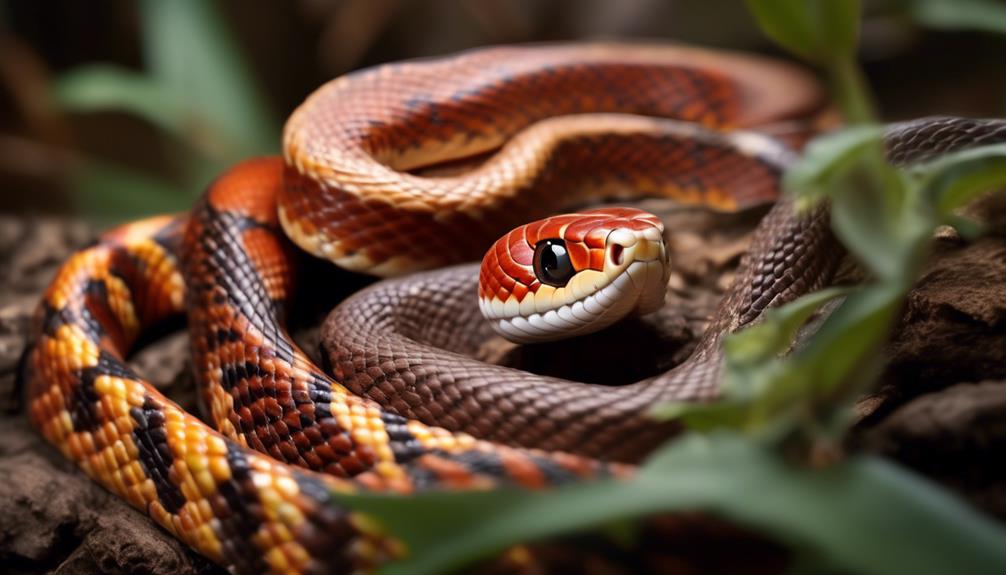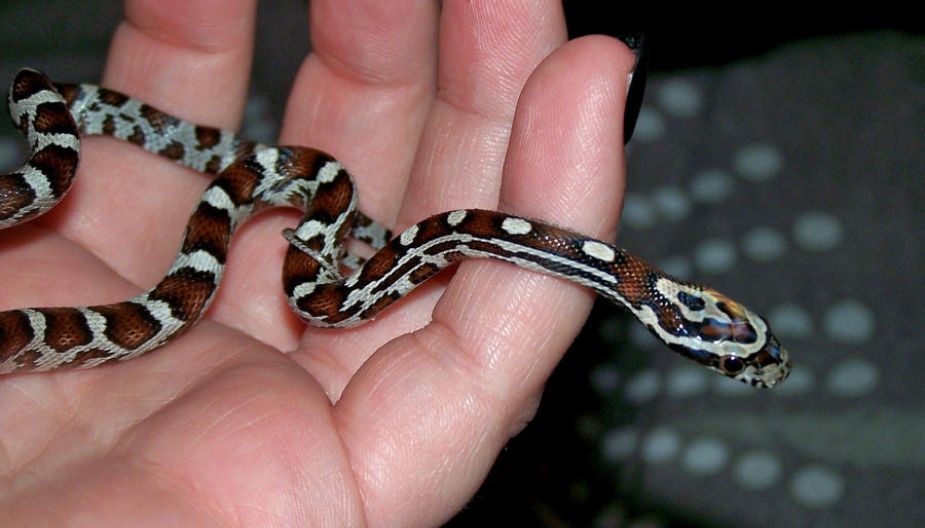Don’t let appearances deceive you when it comes to the corn snake and the copperhead. These two serpents may look similar at first glance, but the differences between them are crucial for staying safe in their respective habitats. Understanding how to distinguish between the harmless corn snake and the venomous copperhead is essential for anyone spending time outdoors. So, how can you tell the two apart and avoid potential danger?
When it comes to identifying these snakes, it’s important to remember that they have distinct features. The corn snake, also known as the red rat snake, has vibrant orange or red scales with large, bold-colored blotches. On the other hand, the copperhead has a more muted coloration, with a coppery or reddish-brown hue and hourglass-shaped markings on its body.
One key way to differentiate between the two is by looking at their heads. The corn snake has a slender head with round pupils, while the copperhead has a broader, triangular-shaped head with slit-like pupils. Additionally, the copperhead’s head has a distinctive pit between the eye and nostril, which is a feature unique to pit vipers like the copperhead.
It’s important to note that the corn snake is a harmless species that plays a valuable role in controlling rodent populations, making it a welcome sight in many ecosystems. On the other hand, the copperhead is a venomous snake with a potentially dangerous bite, so it’s crucial to give it a wide berth if encountered in the wild.
In conclusion, being able to distinguish between the corn snake and the copperhead is essential for staying safe while enjoying the outdoors. By familiarizing yourself with the key differences in appearance and behavior, you can avoid potentially dangerous encounters with venomous snakes like the copperhead. Stay informed, stay alert, and stay safe during your outdoor adventures.
Physical Appearance Comparison
When comparing the physical appearance of a corn snake and a copperhead, one noticeable difference is their distinctive coloration and patterns.
Corn snakes typically have vibrant, bold colors, with a base color that can range from orange and red to brown or gray. They’ve large, dark-edged blotches down the length of their bodies, often resembling the pattern of maize, hence their name.
On the other hand, copperheads have a more muted color palette, often with a coppery or reddish-brown hue. Their bodies are adorned with hourglass-shaped bands that are darker in the center and lighter towards the edges.
In addition to their color patterns, their body shapes also set them apart.
Corn snakes have slender, elongated bodies, with a tapered head and round eyes. Their bodies are built for agility and are well-suited for climbing trees and navigating through foliage.
Conversely, copperheads have a thicker, more robust body shape. They’ve a distinct triangular-shaped head and vertical pupils, characteristic of pit vipers.
These differences in color pattern and body shape are essential for distinguishing between the two species and are crucial for identifying them in the wild.
Habitat and Range Differences
The distinctive color patterns and body shapes of corn snakes and copperheads not only aid in their visual identification but also play a significant role in determining their respective habitats and ranges.
Corn snakes, with their preference for wooded areas, can be found throughout the southeastern and central United States, including states such as Florida, Louisiana, and Kentucky. They thrive in a variety of environments, including overgrown fields, forested regions, and abandoned buildings.
In contrast, copperheads have a more limited range distribution, primarily inhabiting the eastern United States. They favor wooded or rocky hillsides, forests, and areas with a lot of leaf litter. Unlike corn snakes, copperheads are less likely to venture into open fields or urban areas. Additionally, copperheads tend to favor habitats with rocky outcrops, as these provide ideal spaces for shelter and hibernation.
Understanding these range distributions and environmental preferences is crucial for staying safe when encountering these two species in their natural habitats.
Behavioral Contrasts
In observing the behavioral contrasts between corn snakes and copperheads, it becomes evident that their hunting and feeding strategies vary significantly.
Corn snakes, being constrictors, employ a method of subduing their prey by coiling around them, squeezing until the prey suffocates, and then consuming it. In contrast, copperheads, being venomous, use their venom to immobilize and kill their prey before swallowing it whole. This distinct contrast in hunting techniques is crucial for distinguishing between the two species.
Furthermore, another notable behavioral contrast lies in their reproductive behaviors.
Corn snakes are known for their communal nesting habits, where multiple females may lay their eggs together in a shared nesting site. On the other hand, copperheads are solitary and exhibit aggressive mating behaviors. During the mating season, male copperheads engage in ritual combat to compete for mating rights with females. These distinct reproductive behaviors further highlight the differences between the two species.
Understanding these behavioral contrasts is essential for staying safe in their respective habitats. By being able to identify these differences, individuals can better avoid potential encounters with venomous copperheads while appreciating the beneficial presence of non-venomous corn snakes.
Venomous or Harmless: Understanding the Risk
Understanding the behavioral and physical characteristics that differentiate venomous copperheads from harmless corn snakes is essential for assessing the risk of encountering these species in their respective habitats.
Copperheads have a distinctive triangular-shaped head, vertical pupils, and heat-sensing pits between the nostrils and eyes. Their coloration includes dark, hourglass-shaped bands across their bodies, which can blend into their surroundings, making them difficult to spot.
On the other hand, corn snakes have slender bodies, round pupils, and lack the heat-sensing pits and triangular head characteristic of venomous snakes. They’ve vibrant patterns resembling corn kernels, hence their name.
Identifying these characteristics is crucial for your safety. In the event of a snakebite, quick action is vital. If bitten by a venomous snake, it’s important to stay calm, immobilize the affected area below heart level, and seek medical help immediately. Don’t attempt to suck out the venom or apply a tourniquet.
Knowing first aid for snakebites can be life-saving. Understanding the risk associated with encountering venomous snakes and being prepared with the right information and skills can make all the difference in staying safe in snake country.
Safety Precautions and Encounters
To ensure your safety when exploring snake habitats, it’s important to be vigilant and aware of your surroundings at all times.
When encountering snakes, it’s crucial to remember that both the corn snake and copperhead can be found in similar habitats.
To prevent unwanted encounters, wear sturdy, closed-toe shoes and long pants when hiking or exploring areas where these snakes may reside. Be cautious when lifting rocks, logs, or reaching into brush, as these are common hiding spots for snakes.
Additionally, using a walking stick to probe areas before stepping can help alert snakes to your presence and give them the opportunity to move away.
If you do encounter a snake, maintain a safe distance of at least six feet and give the snake space to retreat. Avoid making sudden movements or loud noises, as these can startle the snake.
It’s important to remember that snakes are typically more afraid of humans than humans are of them, and they’ll generally avoid confrontation if given the opportunity to escape.
Frequently Asked Questions
Can Corn Snakes and Copperheads Interbreed?
Yes, corn snakes and copperheads cannot interbreed. Their genetic incompatibility creates reproductive barriers, minimizing hybridization risks. As a result, these species remain distinct and do not produce offspring together.
What Is the Average Lifespan of a Corn Snake and a Copperhead?
So, you’re curious about the average lifespan of a corn snake and a copperhead? Well, corn snakes typically live 15-20 years in captivity, while copperheads usually survive around 18 years in the wild. Reproduction patterns and habitat preferences influence their longevity.
Do Corn Snakes and Copperheads Have Any Predators in Common?
Corn snakes and copperheads share common predators like birds of prey, foxes, and larger snakes. They have different hunting behaviors; corn snakes are constrictors while copperheads use venom to subdue prey. Understanding these differences can help you stay safe in their habitats.
Are There Any Known Myths or Folklore Associated With Corn Snakes and Copperheads?
There are many myths and folklore surrounding corn snakes and copperheads. These cultural beliefs often lead to misconceptions about their behavior and symbolism in art. Understanding the difference in behavior can help dispel these myths.
Can Corn Snakes and Copperheads Coexist in the Same Habitat Without Conflict?
In the same habitat, corn snakes and copperheads may coexist but exhibit different behaviors. Corn snakes tend to avoid confrontation, while copperheads are more territorial. They use distinct ecological interactions to minimize conflict and ensure habitat compatibility.
Conclusion
So, there you have it! The corn snake and the copperhead may seem similar at first glance, but with a keen eye and the right knowledge, you can easily spot the differences and stay safe.
Remember, one is harmless and the other is venomous, so stay alert and follow safety precautions when encountering these snakes in the wild. Don’t be fooled by their appearance – knowing the difference could save you from a dangerous encounter!
And if you want to learn more about reptiles and snake identification, visit Freptiles, a leading website for all things related to reptiles.


